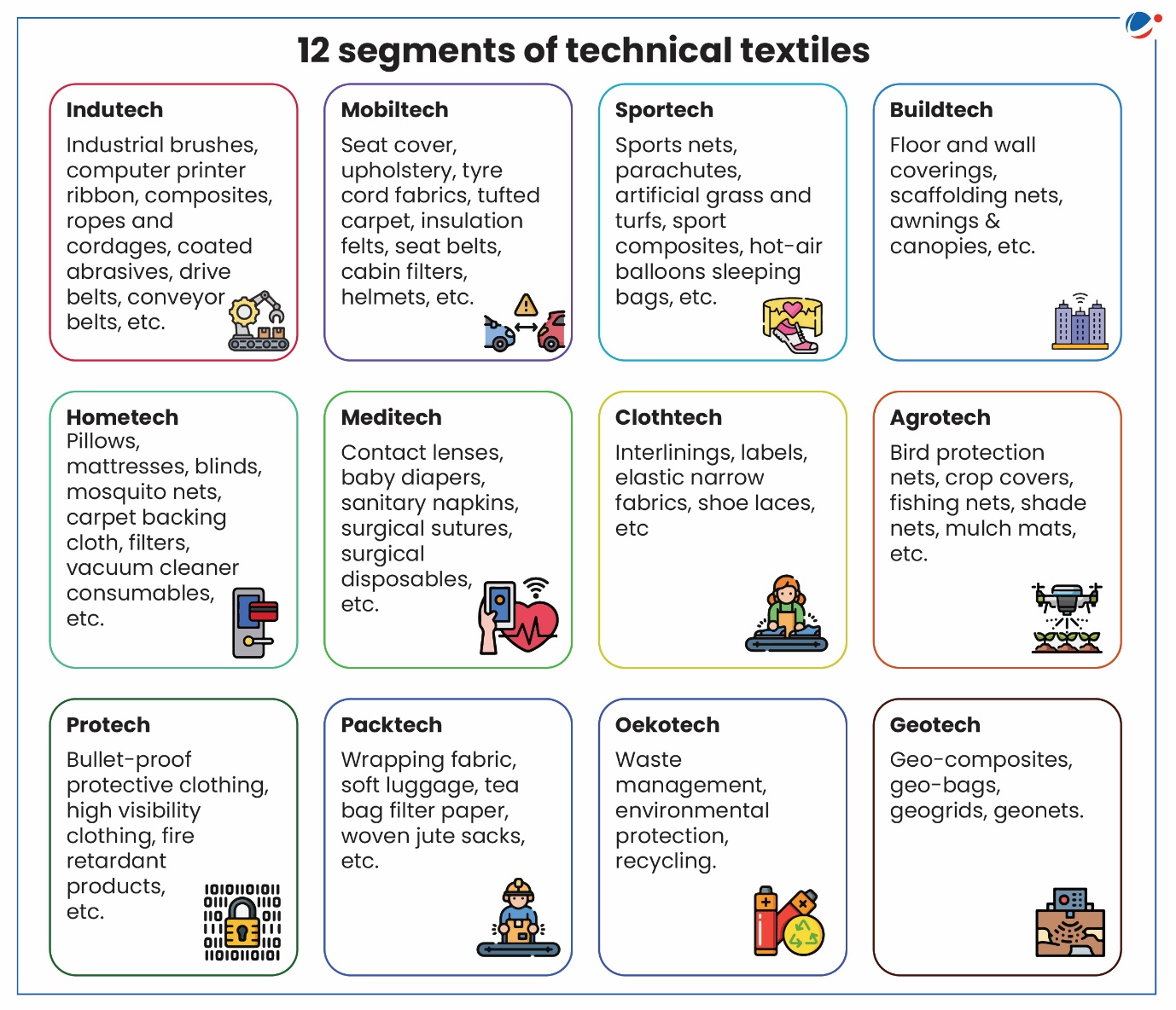Why in the News?
It has been 5 years since the launch of the National Technical Textiles Mission.
Technical textiles are fabrics made for specific functions and performance, rather than for looks.
|
About National Technical Textiles Mission
- Aim: To make India a global leader in Technical Textiles with a budget of Rs. 1,480 crores till 2025-26.
- Ministry: Ministry of Textiles.
- Four Components:
- Research, Innovation and Development.
- Promotion and Market Development.
- Export Promotion.
- Education, Training, and Skill Development.
- Objectives of NTTM: It aims to strengthen India's position as global leader in national textiles by developing an ecosystem around it.

Why Technical Textiles are significant for India?
- Diversified Applications: Indian Technical Textile market is equipped with diversified technical textile innovations.
- For instance, hometech has been used for Antiviral Mattress Protector.
- Agrotech has been used for UV Stabilised and Flexible Crop Support Net.
- Increasing Demand: More consumers have now started to prefer technical textiles over traditional textiles as it fulfils their demand for flexible, durable, high-quality and high strength textiles in activewear or medical apparel.
- Similarly increasing population, rising birth rates and aging population continues to boost the demand for hygienic and personal care medical equipment (meditech), as well as buildtech segments.
- Industrial Production: Indutech are technical textiles used in the industrial (manufacturing) applications like filtration, conveying, cleaning including solutions and products for mechanical engineering and for varieties of industries, e.g. conductive textiles and 3-D textile products.
- Environmental Protection: Technical Textiles, especially Geotech and Oekotech are useful for environment protection – floor sealing, air cleaning, prevention of water pollution, wastewater recycling treatment, erosion protection and domestic water sewerage plants.
- Supports Disaster Management: For instance, in Austria, Geotech barriers used to deflect avalanches from entering the reservoir.
- Defense Modernization: Manufacturing of Protech based bullet proof jackets, protective wear, high strength composite materials under make in India can help in defense modernization.
- Support for Key Sectors: Technical textiles enhance productivity and efficiency in critical sectors like agriculture, healthcare, transportation, and infrastructure, which are foundational to India's economy.
- Geotextiles in railway track construction (e.g., by Indian Railways under NIP) and geomembranes for water conservation (Jal Jeevan Mission) improve infrastructure durability, reducing maintenance costs and supporting long-term economic stability.
Other Steps taken to Promote Technical Textiles
|
Challenges in Leveraging Technical Textiles
- Lack of Awareness: Technical textile benefits remain unknown to the masses due to insufficient marketing and education.
- Import Dependence: India imports significant technical textiles from China (low-cost products) and US/Europe (high-tech products).
- The absence of domestic specialty fiber manufacturing (carbon fibers, Nylon 66, UHMPE) and inverted duty structures favor importing finished goods over raw materials.
- Skilled Workforce Shortage: The industry requires specialized skills currently absent in the domestic workforce.
- Current training schemes focus on traditional textiles rather than developing specific technical textile curricula.
- Insufficient R&D: The industry is dominated by commodity products with limited product diversification.
- Despite government-established Centers of Excellence, industry mindset needs to shift toward innovation and research investment.
- Standardization Issues: Harmonization of Technical Textiles HSN codes and alignment with international standards remains a challenge, complicating trade and quality control.
Way forward
- Strengthen Research and Development (R&D): Prioritize R&D in high-growth segments like Geotech, Meditech, and Agrotech by collaborating with the premiere institutes so as to support cutting edge innovation.
- Increase Export Competitiveness: By harmonizing Indian standards with global norms to enhance product acceptance in international markets.
- Focus on Sustainability and Circular Economy: Promote the use of natural fibers and eco-friendly products like Agrotech nets and Geotech erosion control solutions to align with India's vision of Mission LiFE.
- Leverage Global Best Practices: Adopt advanced manufacturing techniques from leaders like the USA (Sportech innovations) and Germany (Geotech applications) or Israel (Protech innovation) to improve technology readiness levels.



